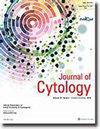MASC被揭露:访问一个罕见的肿瘤,强调细胞形态学特征
IF 1
4区 医学
Q4 MEDICAL LABORATORY TECHNOLOGY
引用次数: 0
摘要
背景:分泌性癌(SC)是一种新发现的肿瘤,在细胞学上常被误诊为腺泡细胞癌。SC的诊断最初是基于荧光原位杂交(FISH)鉴定ETV6:NTRK3融合基因。最近,随着对可靠的组织形态学、细胞学和免疫组织化学特征的更多了解,几乎所有病例都可以在没有FISH帮助的情况下自信地做出明确的诊断。材料与方法:对6例组织学证实的SC病例进行了研究。所有6例的细胞学切片都被检索和审查,以确定可能有助于提高细针穿刺细胞学本身SC的可能性的特征。只要有可能,细胞块也会被研究。结果:患者均为男性,平均年龄35.2岁。本研究中的6例患者在细针穿刺涂片上至少表现出不同大小的局灶性细胞质空泡化、乳头状结构和温和的核特征。S-100和乳蛋白免疫组化(IHC)对诊断有很大帮助。结论:本研究的结果突出了细胞形态学特征,这可能有助于细胞学本身诊断SC。他们还强调了某些细胞学特征,这些特征有助于排除其他鉴别诊断。本文章由计算机程序翻译,如有差异,请以英文原文为准。
MASC gets UNMASKED: Visiting a rare tumor with emphasis on cytomorphological features
Background: Secretory carcinoma (SC) is a newly described entity which has been often misdiagnosed earlier as acinic cell carcinoma on cytology. Diagnosing SC was initially based upon identifying the ETV6:NTRK3 fusion gene with the help of fluorescence in situ hybridization (FISH). Lately, with more knowledge of the reliable histomorphology, cytology, and immunohistochemistry features, definitive diagnosis can be confidently made without the help of FISH in almost every case. Materials and Methods: Six histologically confirmed cases of SC were studied. The cytology slides of all the six cases were retrieved and reviewed to identify the characteristic features which could have helped in raising the possibility of SC on fine needle aspiration cytology itself. Cell blocks were also studied, wherever available. Results: Patients were all male with average age of 35.2 years. The six cases in the current study demonstrated at least focal cytoplasmic vacuolization of varying sizes, papillae formations, and bland nuclear features on fine needle aspirate smears. It was also seen that S-100 and mammaglobin immunohistochemistry (IHC) are very helpful in confirming the diagnosis. Conclusions: The results of the current study highlight the cytomorphological features which may help in clinching the diagnosis SC on cytology itself. They also highlight certain cytological features which help to rule out the other differential diagnoses.
求助全文
通过发布文献求助,成功后即可免费获取论文全文。
去求助
来源期刊

Journal of Cytology
MEDICAL LABORATORY TECHNOLOGY-
CiteScore
1.80
自引率
7.70%
发文量
34
审稿时长
46 weeks
期刊介绍:
The Journal of Cytology is the official Quarterly publication of the Indian Academy of Cytologists. It is in the 25th year of publication in the year 2008. The journal covers all aspects of diagnostic cytology, including fine needle aspiration cytology, gynecological and non-gynecological cytology. Articles on ancillary techniques, like cytochemistry, immunocytochemistry, electron microscopy, molecular cytopathology, as applied to cytological material are also welcome. The journal gives preference to clinically oriented studies over experimental and animal studies. The Journal would publish peer-reviewed original research papers, case reports, systematic reviews, meta-analysis, and debates.
 求助内容:
求助内容: 应助结果提醒方式:
应助结果提醒方式:


